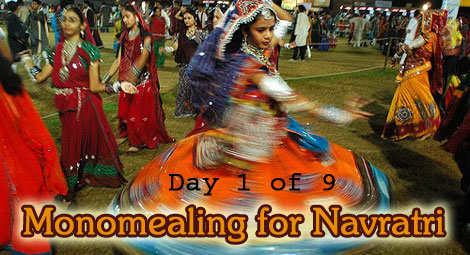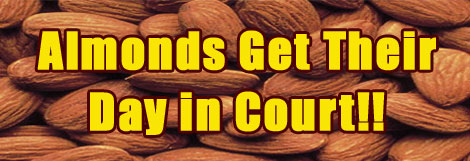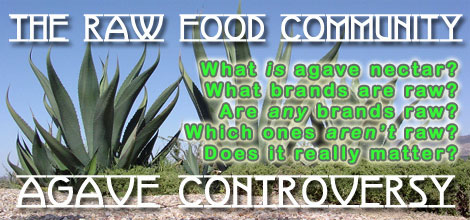
Happy Navratri!
DAY 1:

"I sent out over 100 emails, now, and have been corresponding with the chair of the almond board. He s an ass."~Wendi, writing a few years ago in her "Almond Frustration" blog post.
Jim here again... Wow, that's an excerpt from a very fired-up Wendi, writing a few years ago about her frustration over the USDA's absolutely insane regulation that nearly all almonds sold in the United States must be treated with chemicals or heat prior to sale. I'm sure you know the story by now, so I won't rehash it here. (In case you do not, you can read about it in our original post, Wendi's Almond Frustration post (which even recounts a disturbing, related dream she had about this issue), or our last update post. It's an issue we've been following for years here.)
Read more: One Step Closer to the Return of Truly Raw Almonds!
A worker at our local Food Co Op was talking about making his own dehydrator. I mentioned that I saw a link to a site that told about how to create one and I'd share it with him. When I found the link, just now, I thought maybe some of you might be interested in checking it out, as well.
?The page isn't vegan-friendly (there is ground meat in the one picture), but if you've been wanting a dehydrator and don't want to spend the money on the more expensive ones...this might be a great option.

To keep all of you inspired while we are away, we've asked some
remarkable individuals to share their raw food stories with you. Enjoy!

Here's some coconutty video footage from our Florida Keys excursion. First up is some footage of Randesh, from www.TheGuana.com, who obtains fresh coconuts for Charlie Wilson's Key West restaurant, Help Yourself (see yesterday's blog post).Notice that Randesh uses a proper piece of equipment -- a large machete (or cutlass) -- which makes short, easy work of opening these precious gifts of nature! In the video footage following that, you'll see how comically difficult it is to open a young coconut when you lack the proper equipment. We actually went out looking for a machete, but could only find a large chef's knife at a local K-Mart. Yep, they were sold out of machetes! (Ironically, the chef's knife -- the heaviest one the store had -- cost about $17, while plain old machetes run just $10 or so at most hardware stores. Next time we'll keep looking...)
I've been holding on to some things to share here on the blog, and today feels like a good day to share this particular inspirational gem, below. I hope it speaks to some of you in a way that brings about a deeper love for yourself. Many times I have a feeling, based on emails I receive, that I love some of you more than you love yourselves (and I deeply love all of you). That's okay, though. Your time will come to blossom into the self-loving individual that you know you are at your core. Perhaps today what I share will trigger a deeper sense of self-love for you, as it did for another friend.
Back in October, a friend in an online raw community sent me a message about how she was having a tough time with cravings. I responded to her, as follows:
... You CAN do it, too! For me, it took finally loving myself to make the change. I had to KNOW that NOTHING was going to stop me from loving myself. And loving myself meant never putting harmful things into my body EVER AGAIN! So, once I made that decision, I moved forward. I'm not saying I didn't have cravings, but I loved myself through them! ...
Many times in the online communities, the messages you share with others will also be read by individuals stopping by the pages of your friends. That was the case with what I wrote, above. I received a lovely message from another friend in that community, who had read the message I left for someone else. Here's what she wrote to me:

In this special five-part series, Joanna Steven uncovers where some top vegetarian athletes get their protein. Here's part two, focusing on Koya Webb's take on this issue.
ALMONDS
?The greater the percentage of raw food in the diet, the greater the health benefits? is Koya Webb, fitness model, personal trainer, triathlete and body builder's personal motto. Koya's sculpted physique won 1st place in the Ultimate Fitness Events "Fitness Model" and "Bikini Model" competitions and has modeled for Nike, Adidas, New Balance, Muscle and Fitness, Her Sports, Royal Caribbean and Triathlete magazine, to name a few. As a living-foodist (one who eats 60% or more uncooked veggies, nuts, seeds, and super foods) Koya believes eating all natural ?fruits of the earth? can help heal cancer, diabetes, and other diseases plaguing our society today.
Read more: Vegetarian Athletes Share: Top 5 Sources for Animal-free Protein (Part 2 of 5)
This isn't one of our normal blog posts. It's more of a journal entry, than anything else.
You see, I'm a bit sad today. The Raw Spirit Festival in Santa Barbara, CA, started today and I'm not there. We've been working really hard on many raw food projects, trying to sell our home, etc. So, spending the time and money to travel to the other side of the country for a weekend event just didn't seem like a good idea.I don't think we made the wrong decision, but I do admit I was hoping that somehow the Universe would conspire in some magical way to arrange for me to attend the festival this weekend.
For those who have never been to a Raw Spirit Festival, you might wish that you could attend something so totally awesome---to be surrounded by raw foodies you've met online, to attend the various speeches and events at the festival, etc.---but you probably aren't feeling completely sad that you aren't there. To have attended a Raw Spirit Festival, had your entire life altered by the experience, and then to not attend the next one is almost heartbreakingly sad.
After so looooong, the much-awaited Episode 6 is here of "Know Your Food"! Aren't you thrilled? Well, WE are. We're fantastically excited to announce that we have SIX thrilling new eipsodes "in the can" (as we film buffs like to say). So, here's the first of those six, in which your humble nutrition researchers reveal the hidden secrets of cacao, that delicious tropical ambrosia that opens your heart like nothing else. So, grab a raw chocolate snack of your choice and curl up in front of your favorite flat screen. Here's the vid:
Whoa, what'd you think of the "Monkey Brains" scene ! Have we finally used EVERY SINGLE hoaky feature of the Windows Movie Maker software? (Don't answer... Those were rhetorical questions.) In case you couldn't read some of the nutritional information, here's a summary of the key components of this delicious bounty from the Earth's equatorial regions. Raw chocolate contains:

Within the raw food community, a controversy seems to have been brewing for the better part of a year! The topic: Agave nectar (also called agave syrup). Surely by now most people know what agave nectar is. For anyone who doesn't, it's a thick liquid sweetener made from, you guessed it, the agave plant.
In general, the production of tasty agave nectar involves heating the plant to a certain temperature (which varies widely according to which manufacturer is making it and which species of agave is used). The extent of this heating constitutes a significant part of the controversy (as most raw foodists believe that heating any food over a certain temperature, usually somewhere between 105 and 118 degrees fahrenheit, renders it "dead").
Read more: Pure Jeevan Explores the Raw Food Community's Agave Nectar Controversy

Welcome to Pure Jeevan's "Juice-a-Day Jamboree"! You're probably wondering, "What IS Pure Jeevan's Juice-a-Day Jamboree, anyway " Well, it's simple: It's an ongoing, informal, loosely organized "event" centered around juicing. Think of it as an interim step between (1) any kind of diet or lifestyle, from SAD to full-on raw, that does not include much regular juice, and (2) an all out juice feast where that's ALL you'd consume for a period of time. Basically, we're saying, "Let's just make this simple and accessible for everyone. Let's just make a goal to simply drink more fresh juice!"
Wendi and I have been thinking a lot about incorporating more juicing into our lives lately (which is something we've done off and on over the years but never stuck with long-term). One thing holding us back from doing it more often is the time requirement. When we juice, it usually takes a half hour or so from start to finish. I know it doesn't seem that complicated, but I suppose it's just the whole process of setting up the juicer, washing and peeling the produce, juicing it, setting the juice aside while we clean the juicer, doling out the juice into glasses, cleaning up the mini-mess that makes, and then sitting down to actually enjoy the juice.
